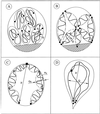A polymer model for large-scale chromatin organization in lower eukaryotes
- PMID: 12058077
- PMCID: PMC117632
- DOI: 10.1091/mbc.02-01-0608
A polymer model for large-scale chromatin organization in lower eukaryotes
Abstract
A quantitative model of large-scale chromatin organization was applied to nuclei of fission yeast Schizosaccharomyces pombe (meiotic prophase and G2 phase), budding yeast Saccharomyces cerevisiae (young and senescent cells), Drosophila (embryonic cycles 10 and 14, and polytene tissues) and Caenorhabditis elegans (G1 phase). The model is based on the coil-like behavior of chromosomal fibers and the tight packing of discrete chromatin domains in a nucleus. Intrachromosomal domains are formed by chromatin anchoring to nuclear structures (e.g., the nuclear envelope). The observed sizes for confinement of chromatin diffusional motion are similar to the estimated sizes of corresponding domains. The model correctly predicts chromosome configurations (linear, Rabl, loop) and chromosome associations (homologous pairing, centromere and telomere clusters) on the basis of the geometrical constraints imposed by nuclear size and shape. Agreement between the model predictions and literature observations supports the notion that the average linear density of the 30-nm chromatin fiber is approximately 4 nucleosomes per 10 nm contour length.
Figures

Similar articles
-
Dynamics of chromosome organization and pairing during meiotic prophase in fission yeast.J Cell Biol. 1994 Oct;127(2):273-85. doi: 10.1083/jcb.127.2.273. J Cell Biol. 1994. PMID: 7929575 Free PMC article.
-
Yeast nuclei display prominent centromere clustering that is reduced in nondividing cells and in meiotic prophase.J Cell Biol. 1998 Apr 6;141(1):21-9. doi: 10.1083/jcb.141.1.21. J Cell Biol. 1998. PMID: 9531545 Free PMC article.
-
Meiosis induced by inactivation of Pat1 kinase proceeds with aberrant nuclear positioning of centromeres in the fission yeast Schizosaccharomyces pombe.Genes Cells. 2004 Aug;9(8):671-84. doi: 10.1111/j.1356-9597.2004.00760.x. Genes Cells. 2004. PMID: 15298676
-
How do meiotic chromosomes meet their homologous partners?: lessons from fission yeast.Bioessays. 2001 Jun;23(6):526-33. doi: 10.1002/bies.1072. Bioessays. 2001. PMID: 11385632 Review.
-
Meiosis. Telomeres lead chromosome movement.Curr Biol. 1994 Aug 1;4(8):724-7. doi: 10.1016/s0960-9822(00)00160-3. Curr Biol. 1994. PMID: 7953561 Review.
Cited by
-
Economy, speed and size matter: evolutionary forces driving nuclear genome miniaturization and expansion.Ann Bot. 2005 Jan;95(1):147-75. doi: 10.1093/aob/mci010. Ann Bot. 2005. PMID: 15596464 Free PMC article. Review.
-
Quantified effects of chromosome-nuclear envelope attachments on 3D organization of chromosomes.Nucleus. 2015;6(3):212-24. doi: 10.1080/19491034.2015.1056441. Nucleus. 2015. PMID: 26068134 Free PMC article.
-
Chromosome looping in yeast: telomere pairing and coordinated movement reflect anchoring efficiency and territorial organization.J Cell Biol. 2005 Jan 31;168(3):375-87. doi: 10.1083/jcb.200409091. J Cell Biol. 2005. PMID: 15684028 Free PMC article.
-
Entropy-driven genome organization.Biophys J. 2006 May 15;90(10):3712-21. doi: 10.1529/biophysj.105.077685. Epub 2006 Feb 24. Biophys J. 2006. PMID: 16500976 Free PMC article.
-
Diffusion and distal linkages govern interchromosomal dynamics during meiotic prophase.Proc Natl Acad Sci U S A. 2022 Mar 22;119(12):e2115883119. doi: 10.1073/pnas.2115883119. Epub 2022 Mar 18. Proc Natl Acad Sci U S A. 2022. PMID: 35302885 Free PMC article.
References
MeSH terms
Substances
LinkOut - more resources
Full Text Sources
Molecular Biology Databases

